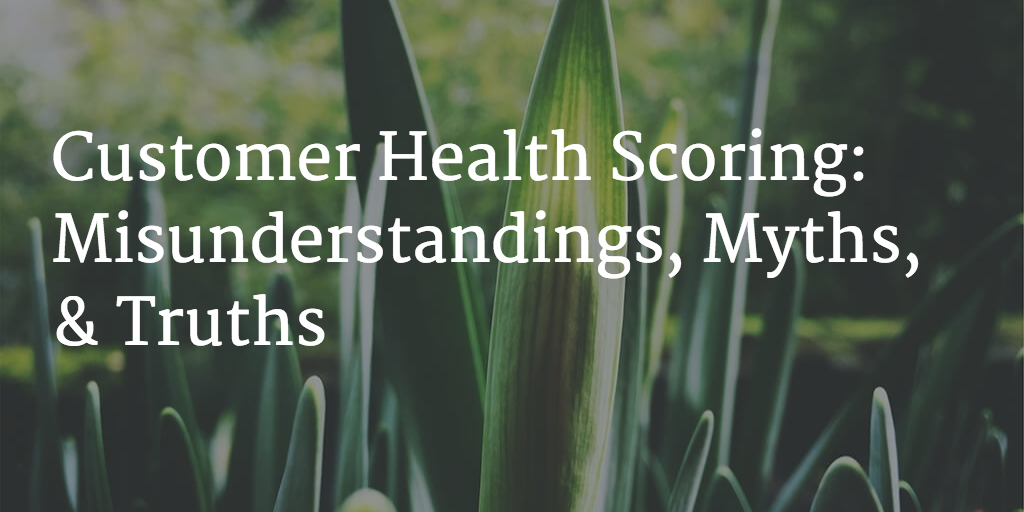Customer Health Scoring: Misunderstandings, Myths, & Truths
Customer health scoring is such a hot topic (one we’ve covered several times before), and fundamental to success in our recurring revenue and subscription world, that I thought I’d try to shine some light into the dark corners of confusion I’ve been seeing and hearing on this subject recently.
At its core, I think the concept of creating customer health scores is pretty simple. The analogy that works well here is to your own personal health. Let’s stretch that analogy a little further and think of a fictional company, HealthCo, whose success depends on your overall health (along with other people) and, ultimately, on your lifespan.
The linkage in our analogy to the B2B world is that death = churn and health ~= retention. For the CEO of HealthCo, given that their business success is tied to your health and how long you live, it will behoove him to closely monitor your health and intervene when they see things that look like risks.
I’m not a doctor so I’ll keep this simple, but let’s assume I’m a Customer Success Manager (CSM) for HealthCo and it’s my job to understand the overall health of my 500 customers/patients. As a result of my monitoring, I’ll determine which of those customers need my attention immediately and which ones will be fine just receiving good advice about nutrition and healthy living from me on a regular basis.
Given that foundation, the question I’m confronted with is what should I be measuring and what’s the process for doing those measurements. One extreme would be to force every customer to come in daily to have a full physical (temperature, blood pressure, blood panels, EKG, EEG, etc.) and to also answer some questions (do you smoke, do you drink, are you a skydiver or firefighter or race car driver, etc.).
On the other extreme, the customer would come in annually for their checkup, which would include all the same tests and questions. Clearly the former method would be preferable but is not feasible. If I could do some monitoring day-to-day or week-to-week, that would be really helpful instead of waiting for that annual checkup to see if everything is OK.
Most people won’t walk around for very long with monitors hooked up to them (although wearable technology might change this) but, to bring this conversation back to the business world, it is feasible to monitor many things about a customer’s health without disrupting their daily lives at all.
One of the points of confusion that I’m hearing is around the idea of a health score being somehow separate from other risk factors. It seems logical, perhaps even mandatory, to me to not think of these as separate elements. Back to the personal health analogy, this would be akin to giving someone a perfect bill of health while knowing that one of the blood tests revealed that they have leukemia.
Even if I knew about the leukemia and informed them in some other way, it seems really obvious that the existence of a deadly disease should be considered part of the assessment of overall health.
Isn’t it a huge paradox to tell someone that their health is A+ except for the fact that they have a fatal condition? Separating these is ludicrous in the extreme.
The B2B equivalent is creating a health score made up solely of inputs that have to do with how the customer is using your product. It might include # of logins, pageviews, reports run, etc. No question that this can be extremely valuable. So let’s say that that methodology yields a health score of 92 (very healthy) for a specific customer. But, at the same time, a survey score of 2 (scale of 1-10) comes in from your business owner for that same customer. And history tells you that 95% of all customers who gave a survey score below 5 within 90 days of renewal ended up churning.
Here comes the $64,000(,000) question – is this a healthy customer? By the “health score” they are.
But isn’t the survey response a big red flag – just like that blood test that shows the patient has leukemia? Given the stats in this hypothetical case, the latter is clearly the answer. If that’s true, shouldn’t the health score include the survey results given that they’ve proven highly meaningful in the past? Of course it should. Who would feel comfortable having their CEO looking at a report showing one of their customers with a health score of 92 when there’s another indicator that says the customer is 95% likely to churn? Certainly not me. I would want the health score to take that survey result into account and contribute to a much lower health score so that anyone who sees it knows that this customer is at risk.
This leads me to the key reason for creating customer health scores. It’s simply a proxy for predicting future customer behavior. 92 might mean that the chances of renewal are 100% and the likelihood of upsell with that renewal (or before) are 90%. Conversely, a score of 15 might mean that there’s a 93% chance that the customer will churn and 0% chance of any upsell.
The reason for creating a health score is the same reason for having a Sales pipeline and moving opportunities through that pipeline. The pipeline helps a Sales VP predict the likelihood of close (and timing), based on which stage the opportunity is in now and the historical close rate for deals in that stage. If your health score does not include ALL the factors that make up overall health, it’s really not a health score.
It’s no different than that “perfect health” assessment for the man who has leukemia. When that patient asks his doctor why he was told that he’s in perfect health when he actually has leukemia, can you imagine the doctor replying “because we don’t count that blood test in our assessment of your health”? Raise your hand if you’d go back to that doctor or recommend him to your friends and family.
A secondary reason for creating customer health scores is that they can be used to drive actions. At a simple level, low scores drive intervention to remedy the challenges and high scores drive Sales or Marketing actions to generate references, case studies, and upsell opportunities. If your health scores mature to the point of being very predictive, which they will, these interventions will be highly relevant and effective.
Yet another reason for driving customer health scores is to help manage your Customer Success team more effectively. Once your health scores are mature and predictive, you can literally manage your CSMs (or Account Managers) based on the movement of health scores across their book of business. Up is good, down is bad. No need to wait to see what their renewal rate is to determine if they are being effective.
This is no different than a Sales VP watching the movement of deals through a Rep’s pipeline. He doesn’t have to wait to see how much business the Rep closes in order to understand whether that Rep is doing the right things to move deals through their pipeline. It’s not perfect, but it’s a proxy.
Lastly, if you do a customer health score by first scoring the components of customer health (usage, support, survey scores, invoice history, relationship, etc.) and then weighting those components to create an overall score, you do something almost magical for your CSMs. If you are measuring them by the movement of their customers’ health scores, they will now have a manageable way to get them there instead of feeling overwhelmed with the need to boil the ocean.
Let’s say I have a customer whose overall score is 63 and I’m going to work on moving them up to 65. In this scenario, I can look at all the health score components and pick the one with the lowest score, let’s say it’s a score of 25 for Support (# of cases opened in the past 30 days). I can now analyze their cases, determine that they are asking lots of “how to” questions on a certain feature, and make sure they have the training video for that feature and maybe spend an hour helping them with their questions.
30 days later, they’ve reduced their number of calls to Support from 12 to 4, their Support score goes up from 25 to 63, and their overall score moves from 63 to 67. Without a scorecard organized in this way and providing these dials and levers (component scores), I would have been randomly grasping at ways to improve this customer’s overall health.
But now I’m empowered to actively manage this customer by using the tools and insights I have at my disposal. Bite-sized tasks. More effective CSMs. Higher health scores. Better renewal and upsell rates. This is the perfect storm of improving customer health, empowering your CSMs, and providing management visibility into the whole picture.
The bottom line is that scoring customer health is pretty much mandatory for any team actively managing customers today. Don’t be confused by the myths out there regarding how to do this. It’s common sense. It may be different for every company, but it’s common sense. There are many things that affect customer health. Some are quantitative (# of logins), some are qualitative (executive relationship). But you almost certainly have a pretty good idea of what they are.
Start with the most valuable ones and bring them together to create a meaningful overall health score for every customer and then refine your model through observation, experimentation, and science. You’ll be starting down the path of making Customer Success very objective and measurable, and you’ll be glad you did.


